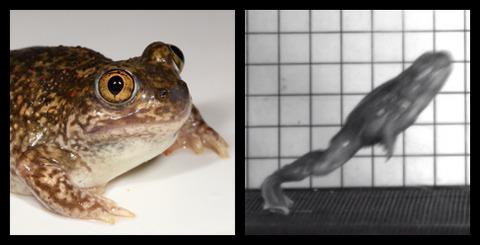当前位置:
X-MOL 学术
›
Funct. Ecol.
›
论文详情
Our official English website, www.x-mol.net, welcomes your feedback! (Note: you will need to create a separate account there.)
What explains vast differences in jumping power within a clade? Diversity, ecology and evolution of anuran jumping power
Functional Ecology ( IF 5.2 ) Pub Date : 2020-03-05 , DOI: 10.1111/1365-2435.13545 Elizabeth Mendoza 1, 2 , Emanuel Azizi 1 , Daniel S. Moen 2
中文翻译:

是什么解释了进化枝中跳跃力量的巨大差异?阿努兰跳跃能力的多样性,生态学和进化
更新日期:2020-03-05
Functional Ecology ( IF 5.2 ) Pub Date : 2020-03-05 , DOI: 10.1111/1365-2435.13545 Elizabeth Mendoza 1, 2 , Emanuel Azizi 1 , Daniel S. Moen 2
Affiliation

|
- Anuran (frog and toad) jumping power varies greatly across species, yet muscle power does not. Given that the jumping power of some species is up to five times higher than typical muscle power, power amplification by elastic elements is suggested to explain this discrepancy. However, the ecological reasons for this variation in jumping power remain unclear. One hypothesis is that small jumpers are limited by the time available to accelerate their body during take‐off, leading to small species needing greater power production than larger species to achieve similar jumping performance. Another (non‐mutually exclusive) hypothesis is that the microhabitat species inhabit may drive variation through trade‐offs with performance in microhabitat‐specific, non‐jumping behaviours.
- We compared jumping power across 68 anuran species that were diverse in evolutionary relationships, microhabitat use and body mass. We used phylogenetic comparative methods to compare the role of microhabitat and body mass in explaining variation in jumping power across species.
- We found the strongest support for a model that included two factors and their interaction. First, as body mass increased, jumping power decreased. Second, species that burrowed showed lower jumping power than species that did not burrow. Third, the interaction between body mass and burrowing behaviour showed that jumping power declines more rapidly with body mass in burrowing species than non‐burrowing species.
- The effect of body mass suggests that interspecific variation in jumping power might be partly explained by scaling relationships. Anurans with small body mass may be able to achieve similar locomotor performance (e.g. takeoff velocity) as those with larger body mass, by more effectively amplifying muscle power. Additionally, the effect of burrowing behaviour suggests that species that use hindlimbs to burrow may experience a reduction in their ability to generate jumping power. This may indicate a functional trade‐off between jumping and burrowing performance.
中文翻译:

是什么解释了进化枝中跳跃力量的巨大差异?阿努兰跳跃能力的多样性,生态学和进化
- 不同种类的无尾类动物(青蛙和蟾蜍)的跳跃力差异很大,而肌肉力量则没有。鉴于某些物种的跳跃能力比典型的肌肉力量高出五倍,建议通过弹性元件的力量放大来解释这种差异。然而,这种跳跃力变化的生态原因仍不清楚。一种假设是,小型跳高运动员受到起飞时加速身体的可用时间的限制,导致与大型物种相比,小型物种需要更大的动力输出才能实现类似的跳跃性能。另一个(非互斥的)假设是,微栖息地物种的栖息地可能会通过权衡取舍来驱动变异,而这种权衡与微栖息地特定的非跳跃行为有关。
- 我们比较了进化关系,微生境的使用和体重各不相同的68种无环物种的跳跃能力。我们使用系统发育比较方法来比较微生境和体重在解释物种间跳跃力变化中的作用。
- 我们发现对包含两个因素及其相互作用的模型的最强支持。首先,随着体重增加,跳跃力量降低。其次,穴居的物种比不穴居的物种表现出更低的跳跃力。第三,体重与穴居行为之间的相互作用表明,与非穴居物种相比,穴居物种的体重跳跃能力下降得更快。
- 体重的影响表明,跳跃能力的种间差异可能部分由比例关系解释。通过更有效地放大肌肉力量,具有小体重的无脊椎动物可以实现与具有大体重的无脊椎动物类似的运动性能(例如起飞速度)。此外,穴居行为的影响表明,使用后肢进行穴居的物种可能会降低其产生跳跃力的能力。这可能表明在跳跃和挖洞性能之间进行了功能取舍。


























 京公网安备 11010802027423号
京公网安备 11010802027423号